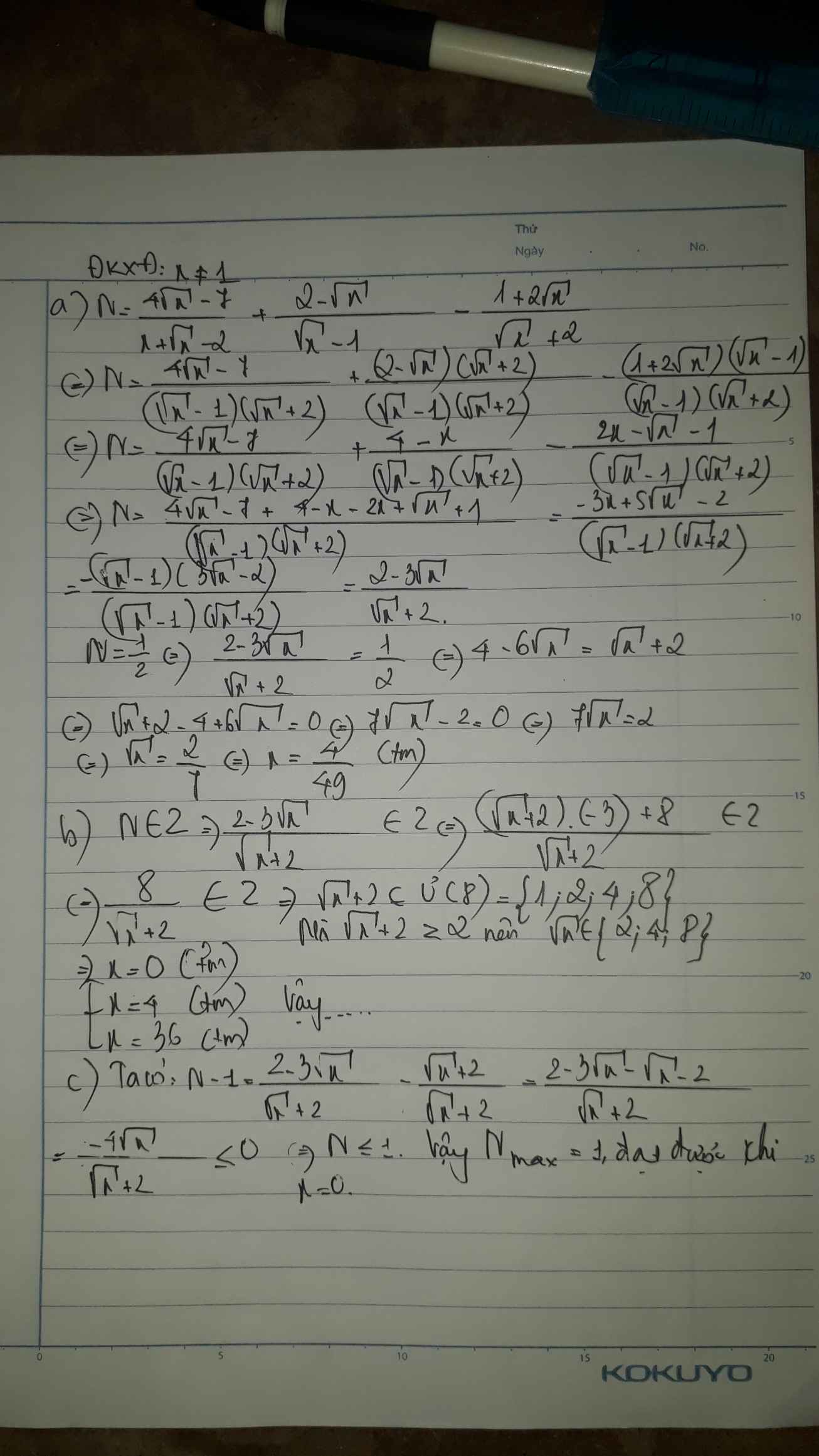Cho P = 1-x²/x a) tìm x để P>-1 b) Tìm x €Z để P €Z c) tìm x sao cho P=-3/2
Hãy nhập câu hỏi của bạn vào đây, nếu là tài khoản VIP, bạn sẽ được ưu tiên trả lời.


Bài 1 :
a, \(A=\frac{2x^2-4x+8}{x^3+8}=\frac{2\left(x^2-2x+4\right)}{\left(x+2\right)\left(x^2-2x+4\right)}=\frac{2}{x+2}\)
b, Ta có : \(\left|x\right|=2\Rightarrow\orbr{\begin{cases}x=2\\x=-2\end{cases}}\)
TH1 : Thay x = 2 vào biểu thức trên ta được :
\(\frac{2}{2+2}=\frac{2}{4}=\frac{1}{2}\)
TH2 : Thay x = -2 vào biểu thức trên ta được :
\(\frac{2}{-2+2}=\frac{2}{0}\)vô lí
c, ta có A = 2 hay \(\frac{2}{x+2}=2\)ĐK : \(x\ne-2\)
\(\Rightarrow2x+4=2\Leftrightarrow2x=-2\Leftrightarrow x=-1\)
Vậy với x = -1 thì A = 2
d, Ta có A < 0 hay \(\frac{2}{x+2}< 0\)
\(\Rightarrow x+2< 0\)do 2 > 0
\(\Leftrightarrow x< -2\)
Vậy với A < 0 thì x < -2
e, Để A nhận giá trị nguyên khi \(x+2\inƯ\left(2\right)=\left\{\pm1;\pm2\right\}\)
| x + 2 | 1 | -1 | 2 | -2 |
| x | -1 | -3 | 0 | -4 |
2.
ĐKXĐ : \(x\ne\pm2\)
a. \(B=\frac{x^2-4x+4}{x^2-4}=\frac{\left(x-2\right)^2}{\left(x-2\right)\left(x+2\right)}=\frac{x-2}{x+2}\)
b. | x - 1 | = 2 <=>\(\hept{\begin{cases}x-1=2\\x-1=-2\end{cases}}\)<=>\(\hept{\begin{cases}x=3\\x=-1\end{cases}}\)
Với x = 3 thì \(B=\frac{3-2}{3+2}=\frac{1}{5}\)
Với x = - 1 thì \(B=\frac{-1-2}{-1+2}=-3\)
Vậy với | x - 1 | = 2 thì B đạt được 2 giá trị là B = 1/5 hoặc B = - 3
c. \(B=\frac{x-2}{x+2}=-1\)<=>\(-\left(x-2\right)=x+2\)
<=> \(-x+2=x+2\)<=>\(-x=x\)<=>\(x=0\)
d. \(B=\frac{x-2}{x+2}< 1\)<=>\(x-2< x+2\)luôn đúng \(\forall\)x\(\ne\pm2\)
e. \(B=\frac{x-2}{x+2}=\frac{x+2-4}{x+2}=1-\frac{4}{x+2}\)
Để B nguyên thì 4/x+2 nguyên => x + 2\(\in\){ - 4 ; - 2 ; - 1 ; 1 ; 2 ; 4 }
=> x \(\in\){ - 6 ; - 4 ; - 3 ; - 1 ; 0 ; 2 }

a: Ta có: \(N=\dfrac{4\sqrt{x}-7}{x+\sqrt{x}-2}+\dfrac{2-\sqrt{x}}{\sqrt{x}-1}-\dfrac{2\sqrt{x}+1}{\sqrt{x}+2}\)
\(=\dfrac{4\sqrt{x}-7+4-x-2x+\sqrt{x}-1}{\left(\sqrt{x}+2\right)\left(\sqrt{x}-1\right)}\)
\(=\dfrac{-3x+5\sqrt{x}-4}{x+\sqrt{x}-2}\)

a, Với \(x\ge0;x\ne1\)
\(B=\frac{1}{\sqrt{x}-1}=2\Rightarrow2\sqrt{x}-2=1\Leftrightarrow2\sqrt{x}-3=0\Leftrightarrow x=\frac{9}{4}\)
b, Ta có : \(A.B=\frac{x+3}{\sqrt{x}+1}.\frac{1}{\sqrt{x}-1}=\frac{x+3}{x-1}=\frac{x-1+4}{x-1}=1+\frac{4}{x-1}\)
\(\Rightarrow x-1\inƯ\left(4\right)=\left\{\pm1;\pm2;\pm4\right\}\)
| x - 1 | 1 | -1 | 2 | -2 | 4 | -4 |
| x | 2 | 0 | 3 | -1 | 5 | -3 |
c, Ta có : \(A=\frac{x+3}{\sqrt{x}+1}\le3\Leftrightarrow\frac{x+3}{\sqrt{x}+1}-3\le0\)
\(\Leftrightarrow\frac{x-3\sqrt{x}}{\sqrt{x}+1}\le0\Rightarrow\sqrt{x}-3\le0\Leftrightarrow x\le9\)
Kết hợp với đk vậy 0 =< x =< 9


a: Để P>-1 thì P+1>0
=>\(\dfrac{1-x^2+x}{x}>0\)
=>\(\dfrac{x^2-x-1}{x}< 0\)
TH1: x^2-x-1>0 và x<0
=>\(x< \dfrac{1-\sqrt{5}}{2}\)
TH2: x^2-x-1<0 và x>0
=>\(\left\{{}\begin{matrix}\dfrac{1-\sqrt{5}}{2}< x< \dfrac{1+\sqrt{5}}{2}\\x>0\end{matrix}\right.\Leftrightarrow0< x< \dfrac{1+\sqrt{5}}{2}\)
b: Để P là số nguyên thì 1-x^2 chia hết cho x
=>1 chia hết cho x
=>\(x\in\left\{1;-1\right\}\)
c: Để P=-3/2 thì \(\dfrac{1-x^2}{x}=\dfrac{-3}{2}\)
=>\(2-2x^2=-3x\)
=>-2x^2+2+3x=0
=>2x^2-3x-2=0
=>2x^2-4x+x-2=0
=>(x-2)(2x+1)=0
=>x=2 hoặc x=-1/2